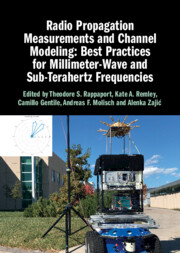Book contents
- Frontmatter
- Dedication
- Contents
- Contributors
- Preface
- 1 Introduction
- 2 Estimating Channel Characteristics from Measurements
- 3 Channel Sounders
- 4 Verification Techniques
- 5 Introduction to Millimeter-Wave Channel Modeling
- 6 Path Loss/Shadowing
- 7 Multipath Component Clustering
- 8 Dispersion Characteristics
- 9 Peer-to-Peer Networking
- 10 Temporal Variance: Literature Review on Human Blockage Models
- 11 Terahertz Channels
- 12 Connection between the Measurements and Models
- 13 Conclusions
- Index
9 - Peer-to-Peer Networking
Published online by Cambridge University Press: 18 August 2022
- Frontmatter
- Dedication
- Contents
- Contributors
- Preface
- 1 Introduction
- 2 Estimating Channel Characteristics from Measurements
- 3 Channel Sounders
- 4 Verification Techniques
- 5 Introduction to Millimeter-Wave Channel Modeling
- 6 Path Loss/Shadowing
- 7 Multipath Component Clustering
- 8 Dispersion Characteristics
- 9 Peer-to-Peer Networking
- 10 Temporal Variance: Literature Review on Human Blockage Models
- 11 Terahertz Channels
- 12 Connection between the Measurements and Models
- 13 Conclusions
- Index
Summary
Device-to-device (D2D) radio channels have fundamentally different properties compared to those of conventional cellular (device-to-infrastructure, D2I) channels. The main reason for this is that most often both the receive antenna and the transmit antenna are located at low heights, and hence there is more interaction with objects in the close neighborhood of the devices. Also, UE mobility, human presence, and finite multipath persistence are the principal factors that degrade link availability. Such models are the focus of this chapter.
Keywords
Information
- Type
- Chapter
- Information
- Radio Propagation Measurements and Channel Modeling: Best Practices for Millimeter-Wave and Sub-Terahertz Frequencies , pp. 211 - 217Publisher: Cambridge University PressPrint publication year: 2022
